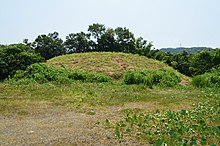Nakagō Kofun Cluster
中郷古墳群 | |
 Mukaideyama Kofun 1 | |
| Location | Tsuruga, Fukui, Japan |
|---|---|
| Region | Hokuriku region |
| Coordinates | 35°38′08″N 136°05′09″E / 35.63556°N 136.08583°E |
| Type | kofun cluster |
| History | |
| Founded | 4th-5th century AD |
| Periods | Kofun period |
| Site notes | |
| Public access | Yes (no public facilities) |
The Nakagō Kofun Cluster (中郷古墳群, Nakagō Kofun-gun) is a group of kofun burial mounds located in the Sakashita neighborhood of the city of Tsuruga, Fukui in the Hokuriku region of Japan. The site was designated a National Historic Site of Japan in 1988.[1]
Overview[edit]
Nakagō Kofun Cluster is located on a hillside east of the centre of the city of Tsuruga facing the Sea of Japan, and consists of two separate groups: the Mukaiyama Kofun Cluster (向出山古墳群, Mukaiyama Kofun-gun) and the Myōjinyama Kofun Cluster (明神山古墳群, Myōjinyama Kofun-gun). These tumuli date from the 4th to 6th century AD and were discovered during the construction of a highway bypass connecting the Hokuriku Expressway with Japan National Route 8, during which time a number of other archaeological discoveries were made, including the Yoshikawa Site, a Yayoi period settlement, and the Kotanigahora Kofun Cluster; however, neither of these sites received government protection and were totally destroyed during highway construction after a hasty compliance excavation. The Nakagō Kofun Cluster itself did not receive full protection, and within the site only Mukaiyama Tombs 1, 3 and 4 and Myōjinyama Tombs 1, 2, 3, 9 and 10 are covered by the National Historic Site designation.[2]
Mukaiyama Tomb 1 was excavated several times starting in 1954, and the two vertical-type burial chambers were opened. Grave goods found include weapons such as swords, spearheads, and fragments of gold-plated armor and helmets, bronze mirrors, and agricultural implements.[2] The weapons in particular are considered to be rare examples nationwide, and have been preserved since 2010 at a private folk museum in Tsuruga.
The tumuli are about 15 minutes by car from Tsuruga Station on the JR West Hokuriku Main Line.[2]
Mukaiyama site[edit]
This site consists of three surviving circular-type kofun (empun (円墳)) on a hilltop ridge in the Yoshikawa neighborhood of Tsuruga. There is an explanatory plaque in front of each tumulus.
- Mukaiyama No.1: A large burial mound from the end of the fifth century, diameter 60 meters, height nine meters in two stages, faced with fukiishi stones. There is also a possibility that it was originally a scallop-shaped tumulus with a total length of 75 meters. There are two pit-type stone chambers at the top of the mound, and a large number of burial items have been excavated. However, the south side is partly missing due to construction work.
- Mukaiyama No.2: This was a circular tumulus from the 5th century, possibility older than Mukaiyama No. 1. It was demolished during the construction work of 1983.
- Mukaiyama No.3: This is a circular tumulus from the second half of the sixth century, with a diameter of 15 meters, a height of four meters, with a corridor-type stone chamber (total length 7.2 meters, length of the entry room 3.7 meters, width of 2.0 meters, height 2.7 meters).
- Mukaiyama No.4: This is a circular tumulus from the second half of the sixth century, diameter eight meters, height two meters, partially collapsed due to overgrowth of trees and plants.
Myōjinyama site[edit]
This site consisted of 23 kofun, of which five survive, on a hilltop ridge in the Sakanoshita neighborhood of Tsuruga. The site does not have any pathways or placards.
- Myōjinyama No.1: Keyhole-shaped tumulus (zenpō-kōen-fun (前方後円墳)) from the 4th century, length 47 meters, height 5.5 meters, faced with fukiishi stones.
- Myōjinyama No.2: Circular tumulus from the 4th century
- Myōjinyama No.3: Keyhole-shaped tumulus from the 4th century, length 53.5 meters, height seven meters
- Myōjinyama No 9: A keyhole-shaped tumulus from the first half of the sixth century, a length of 20 meters, a height of three meters, with a lateral hole type stone chamber
- Myōjinyama No.10: A circular tumulus
See also[edit]
References[edit]
- ^ "中郷古墳群" [Nakago kofun cluster] (in Japanese). Agency for Cultural Affairs. Retrieved August 20, 2020.
- ^ a b c Isomura, Yukio; Sakai, Hideya (2012). (国指定史跡事典) National Historic Site Encyclopedia. 学生社. ISBN 4311750404.(in Japanese)
External links[edit]
- Tsuruga city home page (in Japanese)
- Cultural Heritage of Fukui Prefecture (in Japanese)


